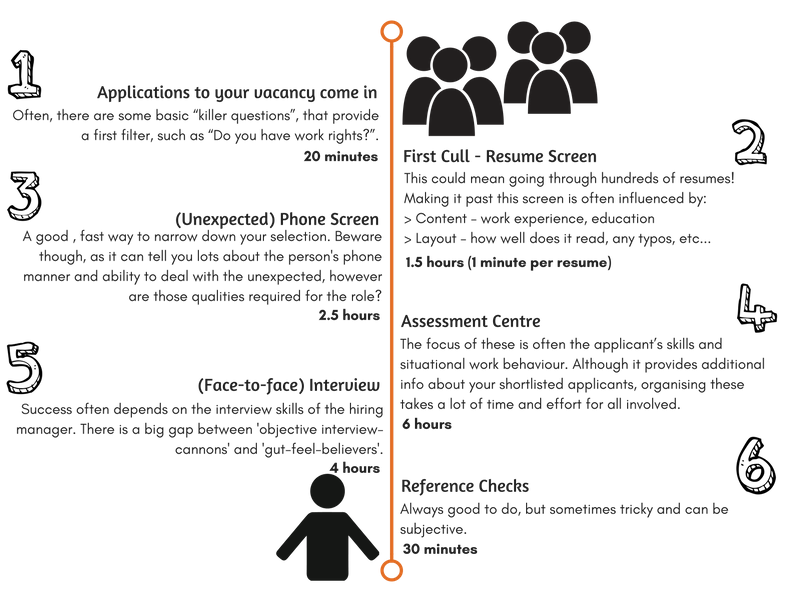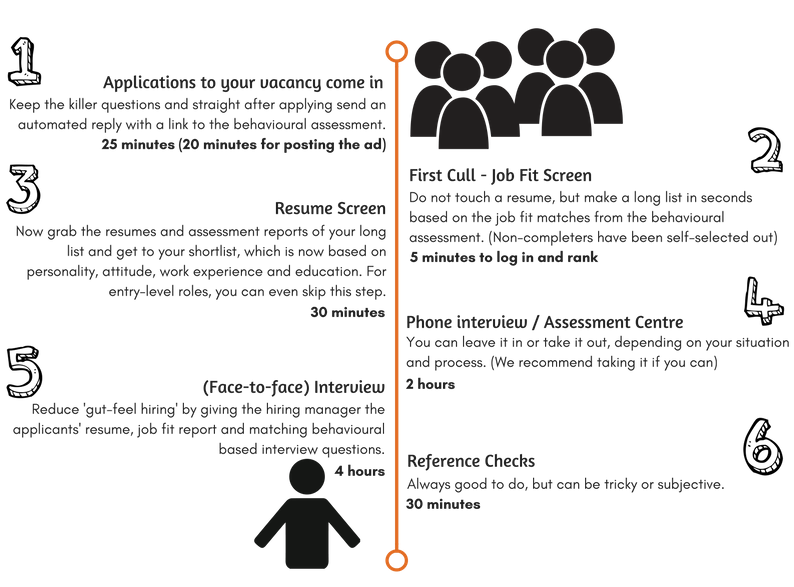Screen smarter, Hire better
14 Nov 2017Recruitment refers to the overall process of attracting, selecting and appointing suitable candidates for jobs within an organisation. Some people have made this their profession and love finding that right match, for others, these activities are a necessary evil to their normal job. No matter which one you are, you probably want to be more efficient with your screening process yet have more insights to make better hiring decisions.
For this article, we will only look at the selecting or screening part of the process, because this is where decisions are made that can either mean a win or a big loss for your organisation.
In the Aged and Community Care sector, the commonly applied screening process looks something like this for a popular frontline care role with, say, 90 applicants:

This probably doesn’t come as a shock, but the resume often doesn’t say anything about the applicant’s personality, values, work behaviours and motivation, unless they specifically included this, which is the exception to the rule. And did you know that hiring someone based on their resume alone has a predictive validity of just 0.2 (if that, as this number can be lower depending on the study*)? This pretty much means that the resume poorly predicts an applicant’s success in the role, however, the first cull is often based on this piece of information alone. Think about all the talents that you could miss out on just because of their resume. Thereby, the resume screen is a huge time consumer/waster, especially for those popular entry-level roles!
We are seeing some large levels of turnover in the sector, which has an industry average of around 25%. The cost of turnover is approximately 20% of that employee’s annual salary, making replacing staff very costly so something you want to get right from the start.Example:

There are many reasons that staff leave your business and a certain level of turnover is considered healthy, but do you keep track of what percentage of your staff has left for personal reasons (moving town, retiring, health issues) or because they were let-go by you? When we look at the reasons that staff are terminated by the organisation, these are often summarised as “they were fired for who they are and how they behaved on the job”.
So how can we find out more about our (frontline) applicants, their personality and work behaviours early on in the process and not solely base our first cull on what they know or can do?
Enter behavioural screening. We know that psychometric assessments are not revolutionary to the screening process, but it is proven and ever-evolving. We have now entered the era of the 6th generation of psychometric screening and are seeing a shift in focus from testing skills and aptitude to finding people with the right personality and attitude for the job. Because if you select those people who are more likely to have the right personal attributes and work attitudes for the role, then you already have a head-start to reducing the number of people you will eventually fire for “who they are”. Studies* show that using behavioural and cognitive assessments in combination with a validating interview has a predictive validity of .76. That’s pretty much as high as it gets.So, let’s see what the recruitment process can look like when adding behavioural screening.

Adding behavioural screening at the top of the screening funnel can take the screening part down to a little over 5 hours with an increased predictive validity! The time saving is achieved by reading fewer resumes and in this case as well by the removal of the assessment centre step in the process. However additional time savings can be found in a reduction in no-shows at interview, a more structured interview process, better hiring decisions and thus reduced staff turnover (saving you time recruiting again!). As you can see below, in our example this company reduced their staff turnover by 5% saving themselves annually $80,000 in recruitment and related costs.
Example – reduced turnover

* https://hbr.org/2014/08/the-problem-with-using-personality-tests-for-hiring






